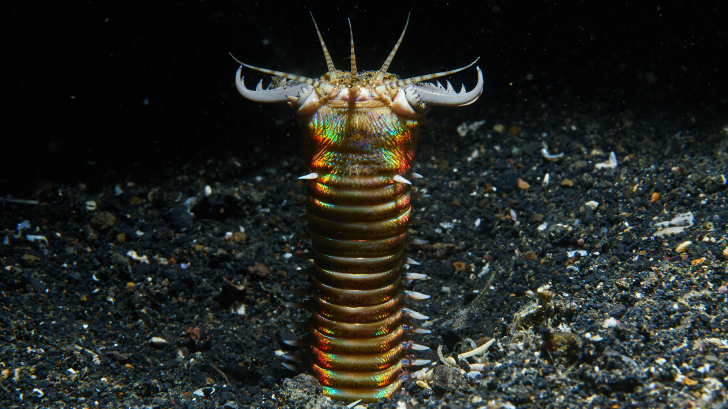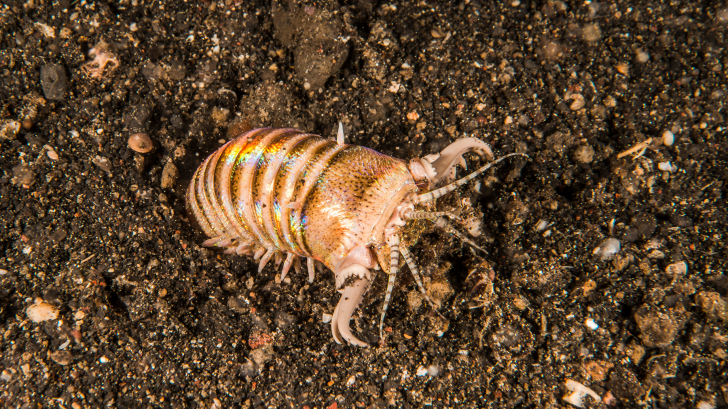Lurking in the seas of Indonesia is a fearsome predator bearing jaws fringed with razor-sharp spikes. Hapless fish – even predators on the hunt themselves – cannot escape if seized. So sudden and fierce is the snap of its jaws, prey may be sliced instantly in two, as if put to death by a bionic marine guillotine.
The oceans are heaving with fearsome predators, but there is something particularly odd about this one: it is not a clever cephalopod (octopuses and cuttlefish), a sophisticated cetacean (dolphins and whales) or monomaniacal elasmobranch (sharks and rays).
It is a worm.
A polychaete to be precise, a class of bristled worm found in the oceans (and occasionally on land) that are a world apart from the everyday squirming annelids we find in our gardens.

“Marine worms are not boring at all, they are very different to earthworms – they come in a huge variety of shapes and colours, and live in a wide range of habitats,” says Joana Zanol, Adjunct Professor in the Department of Invertebrates at the Federal University in Rio de Janeiro.
“I began to explore their evolution as an undergraduate, looking at their phylogenetic trees – I found myself fascinated by their sheer diversity. That’s how I found myself trapped by the strange animals.”
And the Bobbitt worm (Eunice aphroditois, also known as the sand striker) is one of the very strangest. Growing up to 3m in length, the ambush predator buries its long body in the sand, leaving only its mouthparts poking out. At night it spreads wide its jaws and five antennae… and waits. Any unlucky animal – whether it be fish or shrimp, snail or squid – that triggers the sensitive antennae will find itself instantly attacked by a lunging pair of jaws at the end of a iridescent rainbow-coloured segmented tube.
The nickname “Bobbitt” can refer to a variety of large eunicid worms, all of which are cut from the same cloth in lifestyle and appearance: they hide their long bodies in rock, coral or sediment, and ambush prey at night. But the classic “Bobbitt worm” is E. aphroditois. Though biologists have known of it since 1790, the creature was given its sinister nickname in a 1996 field guide, in reference to John and Lorena Bobbitt (millennials who may not have heard of them – look it up). This led to the popular myth that female Bobbitt worms cut off the genitalia of male worms and feed it to their young, which is of course not true: worms not only do not have penises, they are usually hermaphrodites.
For such a notorious and charismatic animal, celebrated in field guides and zoophile blogs, it is very rarely seen. Zanol recently traveled to East Timor on a National Geographic grant, and didn’t find a single one.
“I have been trying to see them for a very long time,” she says. She hasn’t even seen the related two species of eunicid worm that live in the coastal areas of Brazil near to her. “I have never seen large specimens alive – only in museums.”

So elusive are eunicid worms, they can evade detection in aquarium tanks for years if they are accidentally imported while young and living inside coral or rock. There they can comfortably hide during the day, emerging to snatch fish overnight. There have been numerous cases of fish mysteriously disappearing from tanks for years, even decades, before the worms have been found.
In 2013 a metre-long worm was found by staff at Maidenhead Aquatics in Woking, Surrey, which they estimate had been living in the tank for 10 years undetected. An even larger worm was found in 2009 at the Blue Reef Aquarium in Newquay, which had been devouring fish and even snapping bits of coral off the tank’s reef installation; the staff nicknamed it “Barry”. Further afield, a 3m long worm was discovered in a mooring raft in Japan’s Seto Fishing Harbour in 2009 – one of the largest specimens ever discovered.
Clandestine hunting in aquarium tanks make for colourful news stories, but the ability of these worms to travel long distances while still small – especially during the larval stage, when they are probably suspended in the water column and not buried in the sand – means they have the potential to spread around the world.
“Other polychaete worms have become invasive species when transported in ballast water or by the aquarium trade, so Bobbit worms potentially could do a lot of damage if they become invasive species in the same way,” says Anja Schulze, Associate Professor in the Marine Biology Department at the University of Texas. “But we just don’t know, because we know so little about the animals overall.”
We do not know how the worms reproduce, why they have rainbow colouration, how long they live, how fast they grow, if smaller ones are always younger than larger ones, how many different related species there are, what their distribution is, or how abundant they are. For such a famous worm, we still know very little.
“Part of the reason is that it’s not easy to experiment with them in lab settings: raising their larva and raising them to a sexually mature age is not easy to do,” says Schulze. So for now, their reproduction remains a mystery – despite the suggestive moniker.
Zanol says in an ideal world, she would have the ability to raise them in the lab, sequence the DNA of as many field specimens as she can, use that data to work out the true shape of the family tree, and then use that to understand global distribution patterns – like the work she has done on other related worms for over a decade.
Until that happens, their fearsome reputation for slicing fish in half will precede them.
… and if that wasn’t enough to creep you out, last year Swedish biologists in the journal Nature the discovery of the world’s oldest known “Bobbitt worm”: an extinct 400 million year old fossil of a giant polychaete worm, which they named Websteroprion armstrongi, with jaws several times larger than today’s living “Bobbitt worms”. It’s not in the same family as the modern E. aphroditois, but in a related branch of the giant worm family tree.
“Because the only parts of a worm’s body that tend to fossilize are the jaws, us hardcore nerds focus on those because they contain clues to the evolutionary history of all worms,” says Professor Mats Eriksson of the Lithosphere and Biosphere Science at Lund University and lead author of the study.
“To be honest, I’m not a huge fan of living forms of worms – they are interesting, but I also find them kind of gross – so in a way, I feel fortunate being a paleontologist. These giant extinct worms have long since died and turned to stone.”